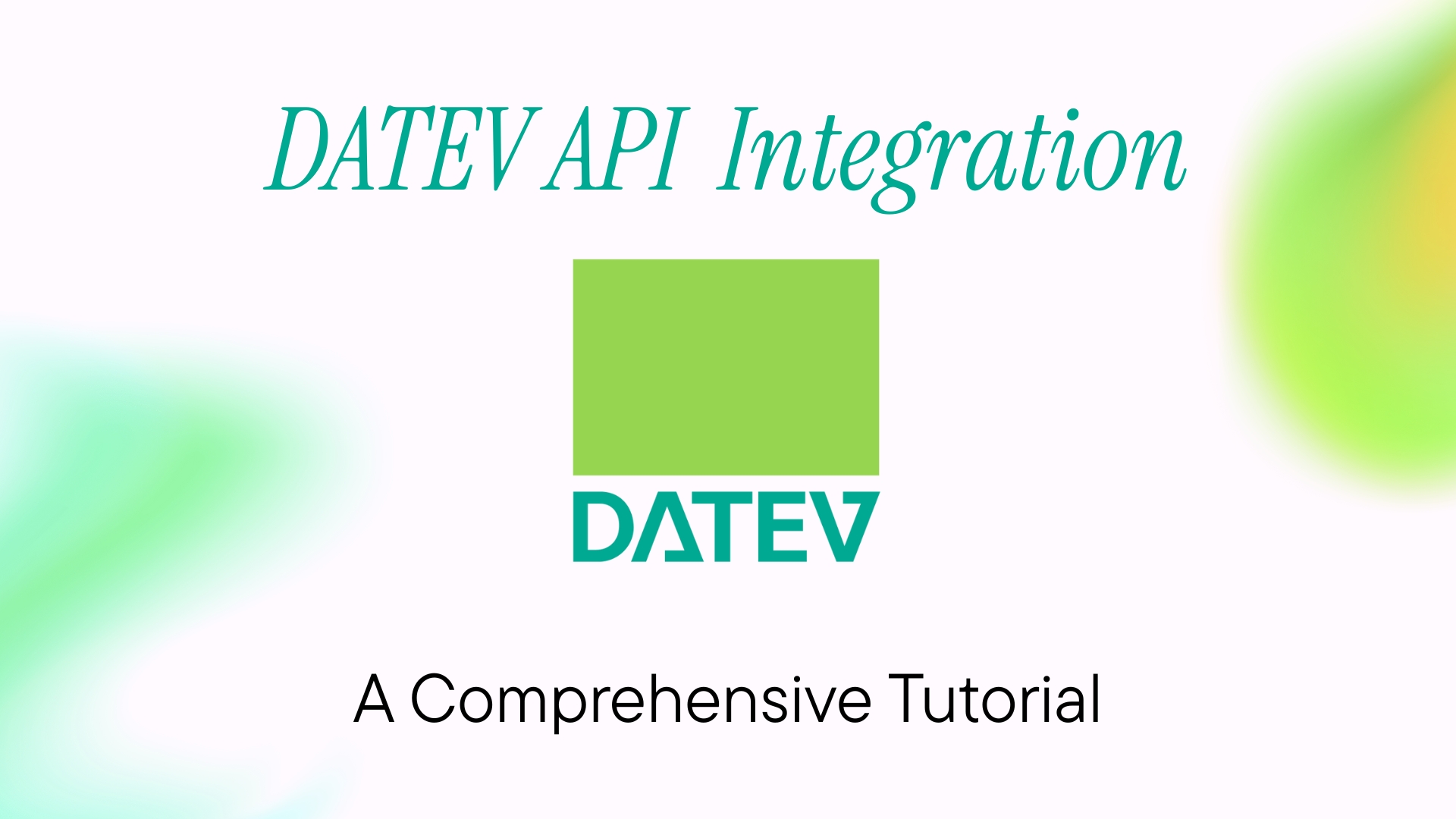When German businesses need accounting software, they turn to DATEV. With decades of market dominance and adoption by thousands of tax consultants across Germany, DATEV has become the de facto standard for financial record-keeping in the German market. But here's where things get interesting for developers: integrating with DATEV isn't like connecting to your typical REST API. The architecture is fundamentally different, and understanding these differences is critical to building a successful integration.
If you're building an ERP system, e-commerce platform, or any business application that needs to sync financial data with German accounting workflows, you'll need to understand how DATEV integration actually works. This guide will walk you through the technical architecture, explain why DATEV takes a batch-processing approach instead of real-time REST calls, and show you the practical steps for implementing a robust integration.
Understanding DATEV API Integration
DATEV API integration connects your third-party platform to DATEV's accounting software ecosystem, enabling automated synchronization of financial data without manual file imports or error-prone copy-paste workflows. When you integrate with DATEV, you're connecting to the systems used by tax consultants and accountants across Germany to manage client finances, prepare tax filings, and maintain compliance with German accounting regulations.
The typical use cases span multiple business domains. E-commerce platforms sync order data and payment records. Banking systems push transaction updates for reconciliation. Property management software sends rent payments and tenant invoicing data. Payroll systems transfer employee expense information. In each case, the goal is the same: eliminate manual data entry, reduce errors, and enable real-time visibility into financial operations.
What makes DATEV integration valuable is the automation of repetitive accounting tasks. Instead of your accountant manually importing CSV files and checking for discrepancies, your integration automatically creates properly formatted records that flow directly into the accounting workflow. Invoice data, customer and supplier records, journal entries, cost center allocations, and VAT calculations all sync automatically. The result is enhanced compliance with German accounting regulations, reduced data errors, improved accuracy, and proactive financial management based on current data rather than week-old exports.
The Two Types of DATEV APIs
Here's where DATEV diverges sharply from typical API architectures. DATEV offers two primary data exchange formats, and neither one works like the REST or SOAP APIs you're probably familiar with. Understanding this distinction is absolutely critical before you start building your integration.
The CSV-based API, used for DATEV Rechnungswesen (abbreviated as ReWe), handles finalized financial bookings and accounting records. When you need to submit completed transactions that are ready for the permanent accounting record, you use this approach. Data flows through flat, tabular CSV files that must follow precise column formatting requirements. These files are processed through batch jobs called EXTF-Jobs. This approach is common in on-premise environments and legacy integrations where the infrastructure was built before cloud-native architectures became standard.
The XML-based API, used for DATEV Unternehmen Online (abbreviated as DUo), handles booking suggestions and invoice processing. This format supports complex, hierarchical data structures that represent more nuanced financial information. Data moves through structured XML files that are validated against XSD schemas to ensure compliance. These files are processed with batch jobs called dxso-Jobs. The XML approach focuses on cloud platforms and modern workflows, particularly for scenarios where you're proposing bookings that require accountant review before finalization.
Now here's the critical point that trips up many developers: DATEV does not use traditional REST or SOAP APIs for core accounting operations. If you're expecting to make HTTP POST requests with JSON payloads and get immediate synchronous responses, you're approaching this wrong. DATEV's integration relies on asynchronous batch-based file processing. You submit files as jobs, those jobs enter a processing queue, and DATEV systems handle them on their own schedule. You cannot use typical RESTful calls for submitting bookings or financial records.
There are some exceptions worth noting. DATEV does offer REST endpoints for certain niche products. The Cash Register Import API (MeinFiskal) provides documented REST endpoints for importing electronic cash register data. The Document Management system integrates via REST APIs through DATEVconnect for document workflows. But these are specialized use cases, not the core accounting functionality.
Third-party unified API providers sometimes expose REST endpoints that make DATEV integration feel more familiar to developers. But understand what's happening under the hood: these are wrappers that translate your REST calls into DATEV's batch processing behind the scenes. The underlying architecture remains batch-based, even if the developer experience feels more REST-like.
Working with the accounting:documents API
Let me show you a practical example using the accounting:documents REST API, which handles document uploads to Belege online in DATEV Unternehmen online. This is one of the REST endpoints that DATEV provides, and it demonstrates the authentication and data handling patterns you'll encounter.

First, you need to retrieve the list of clients your authenticated user can access. This establishes which companies you have permission to integrate with:
GET https://accounting-documents.api.datev.de/platform/v2/clients
Authorization: Bearer {access_token}
X-DATEV-Client-Id: {your_client_id}
The response gives you client identifiers that you'll use in subsequent requests:
[
{
"client_number": 1,
"consultant_number": 455148,
"id": "455148-1",
"name": "Muster GmbH 1"
}
]
That id field is the technical identifier you'll use for all data operations. Notice that it combines the consultant number and client number, creating a unique reference for this specific client within the DATEV system.
Before uploading documents, you should check what document types are available for this client. Document types determine how DATEV processes and categorizes your uploads:
GET https://accounting-documents.api.datev.de/platform/v2/clients/455148-1/document-types
Authorization: Bearer {access_token}
X-DATEV-Client-Id: {your_client_id}
This returns the configured document types:
[
{
"name": "Rechnungseingang",
"category": "invoices_received",
"debit_credit_identifier": "debit"
},
{
"name": "Rechnungsausgang",
"category": "outgoing_invoices",
"debit_credit_identifier": "credit"
},
{
"name": "Kasse",
"category": "other_documents"
}
]
Now you can upload a document. This uses multipart form data to combine the file with metadata:
POST https://accounting-documents.api.datev.de/platform/v2/clients/455148-1/documents
Authorization: Bearer {access_token}
X-DATEV-Client-Id: {your_client_id}
Content-Type: multipart/form-data
--boundary
Content-Disposition: form-data; name="file"; filename="invoice-2024-001.pdf"
Content-Type: application/pdf
[Binary PDF content]
--boundary
Content-Disposition: form-data; name="metadata"
Content-Type: application/json
{
"document_type": "Rechnungseingang",
"note": "Supplier invoice for office supplies",
"category": "MyERP",
"folder": "Invoices",
"register": "2024/10"
}
--boundary--
The metadata structure organizes documents within DATEV's document repository using a three-level hierarchy: category, folder, and register. If you specify any of these levels, you must provide all three. This organizational structure helps accountants locate documents efficiently within the DATEV interface.
When the upload succeeds, you receive confirmation with file details:
{
"file": [{
"name": "invoice-2024-001.pdf",
"size": 125742,
"upload_date": "2024-10-09T14:23:12+02:00",
"media_type": "application/pdf"
}],
"document_type": "Rechnungseingang",
"note": "Supplier invoice for office supplies"
}
Authentication and Authorization
DATEV uses OAuth2 for authorization, particularly for cloud-based integrations with Unternehmen Online. You need to design secure user consent workflows that clearly explain what data your application will access and how it will be used. Many integration scenarios require third-party approval or validation from the tax consultant who manages the client's account, since tax consultants control client access within the DATEV ecosystem.
Your OAuth implementation should support long-lived tokens with automatic renewal processes. This is critical because DATEV integrations often need continuous data synchronization without requiring users to re-authenticate frequently. Users expect their accounting data to flow automatically once they've granted initial consent.
The typical OAuth flow follows this pattern: redirect the user to DATEV's authorization endpoint, receive an authorization code after the user grants consent, exchange that code for access and refresh tokens, and use the access token for API requests. When the access token expires, use the refresh token to obtain a new access token without requiring user interaction.
Data Format Compliance and Validation
DATEV enforces strict format requirements because accounting data must maintain audit compliance and regulatory standards. The CSV and XML formats are fixed specifications that vary by product. You cannot choose arbitrary formats or invent your own column structures.
For XML submissions to Unternehmen Online, your files must validate against DATEV's XSD schemas before processing will succeed. The schemas define required fields, data types, value constraints, and structural relationships. XML validation failures result in immediate job rejection with error codes that indicate which validation rules you violated.
CSV files for Rechnungswesen demand precise column formatting. Each column must contain the correct data type in the expected position. Column order matters. Field delimiters must match the specification exactly. Even minor deviations cause processing failures because the DATEV import engine cannot risk misinterpreting financial data.
Beyond basic format validation, you must properly structure metadata that accompanies your financial records. Cost center allocations, voucher numbers, analytic account references, and VAT information all need to follow DATEV's coding schemes. German VAT codes, for instance, follow specific conventions that DATEV recognizes and validates against current tax regulations.
Common Error Scenarios
The OpenAPI specification documents numerous error codes you'll encounter. Let me walk through the most common ones and what they mean for your integration.
Error #DCO01010 restapi.InvalidDocumentTypeFault occurs when you specify a document type that doesn't exist for the client. Remember that each client configures their own document types. You must query the available types first and only use values from that list. Don't assume standard document types exist universally.
Error #DCO01015 restapi.UnsupportedFileTypeFault indicates the file format isn't accepted. DATEV restricts uploads to specific file types for security and compatibility reasons. The allowed formats vary between DuoNext and legacy systems. Always check the permitted file extensions for your target environment.
Error #DCO01016 restapi.FileSizeFault means your file exceeds the twenty-megabyte limit. Large files create processing and storage burdens. If you're handling oversized documents, you'll need to compress them, split them into multiple uploads, or reconsider your document workflow. DATEV recommends warning users when files exceed 500 KB because even allowed file sizes can slow down system performance.
Error #DCO01253 restapi.DuplicateFileFault signals that a file with identical name and document type already exists in Belege Online. DATEV prevents duplicate uploads to avoid confusion. Your integration should either generate unique filenames, allow users to specify different document types for duplicates, or implement deduplication logic before attempting uploads.
Integration Approaches: Direct vs. Unified APIs
You face a fundamental architectural decision: integrate directly with DATEV or use a unified API provider that abstracts the complexity. Each approach has distinct tradeoffs that affect your development timeline, maintenance burden, and feature coverage.
Direct integration with DATEV gives you complete control over the integration logic. You're not dependent on third-party service availability or pricing changes. You can access all DATEV features without waiting for a middleware provider to expose them. But this control comes with significant complexity. You need deep understanding of CSV and XML format specifications. You're responsible for all batch job management, status monitoring, error handling, and retry logic. Testing requires thorough validation across different client configurations and fiscal year setups. Development cycles stretch longer because you're implementing the entire integration stack yourself. Ongoing maintenance becomes a permanent operational burden as DATEV updates their APIs and format requirements.
Unified API providers like Chift, Maesn, and others offer a RESTful developer experience that feels familiar to modern web developers. These platforms automatically handle batch job creation and management behind the scenes. They provide built-in error handling and retry logic that's been tested across many production deployments. Most importantly, they support multiple accounting platforms beyond DATEV, so your integration code can potentially connect to QuickBooks, Xero, NetSuite, and other systems using the same API patterns. Time to market drops dramatically because you're leveraging pre-built infrastructure. Maintenance overhead shifts to the unified API provider.
The downsides of unified APIs include dependency on third-party service reliability and additional costs beyond DATEV's pricing. Not all DATEV features may be exposed through the unified API wrapper, potentially limiting your integration's capabilities. You're also adding network hops and processing delays compared to direct DATEV communication.
For most development teams, especially those building multi-platform integrations or operating under tight deadlines, unified API providers offer the better path. The productivity gains and reduced maintenance burden usually outweigh the additional costs and potential feature limitations. Direct DATEV integration makes sense primarily for specialized use cases that require features not available through unified APIs, or for large-scale deployments where the volume justifies investing in custom infrastructure.
Practical Implementation Considerations
When you start implementing your DATEV integration, several practical concerns will surface immediately. File naming conventions matter more than you might expect. DATEV recommends UTF-8 encoding with precomposed Unicode characters. Decomposed characters cause problems. Special characters like umlauts must be single code points, not multi-byte sequences. DATEV maintains a whitelist of permitted characters in filenames, and unsupported characters get replaced with underscores automatically. This can create confusion if your system generates filenames with characters outside the whitelist.
Rate limiting and batch processing constraints affect how you design your data synchronization strategy. You cannot stream continuous updates in real-time. Instead, you batch operations and submit them periodically. Determine appropriate batch sizes that balance efficiency against error handling complexity. Larger batches process more efficiently but make error diagnosis harder when something fails.
Error recovery needs thoughtful design because batch processing creates asynchronous failure modes. When a job fails, you need to detect the failure, parse error messages, determine which records caused problems, and decide whether to retry the entire batch or just the failed records. Your integration should implement exponential backoff for transient failures while permanently failing for validation errors that won't resolve through retries.
Testing strategies require access to DATEV sandbox environments. The API specification shows separate endpoints for sandbox testing. Use these extensively before deploying to production. Test with various client configurations, different fiscal year setups, and edge cases in your data. Remember that DATEV may automatically generate subsequent fiscal years under certain conditions, so test your integration's behavior when fiscal year transitions occur.
Final Recommendations
DATEV integration is fundamentally different from typical REST API integration work. The batch-processing architecture, strict format requirements, and certification processes create complexity that shouldn't be underestimated. Before starting development, evaluate your technical resources honestly. Do you have developers with experience in batch processing systems? Can you invest time in understanding DATEV's specific format requirements? Do you need features that unified API providers don't expose?
For most teams, starting with a unified API provider offers the fastest path to a working integration. You can always migrate to direct DATEV integration later if specific requirements demand it. Focus initially on understanding the business workflows, data mapping requirements, and error handling strategies. These concerns remain constant regardless of whether you integrate directly or through middleware.
Document your integration thoroughly, especially the format specifications and validation requirements. Future developers maintaining your integration will need this context. Build comprehensive error logging from day one because diagnosing batch processing failures requires detailed audit trails.
DATEV integration enables powerful accounting automation, but success requires respecting the architectural constraints and compliance requirements that make DATEV the trusted standard for German accounting workflows.
Ready to get started?
Scale your integration strategy and deliver the integrations your customers need in record time.








